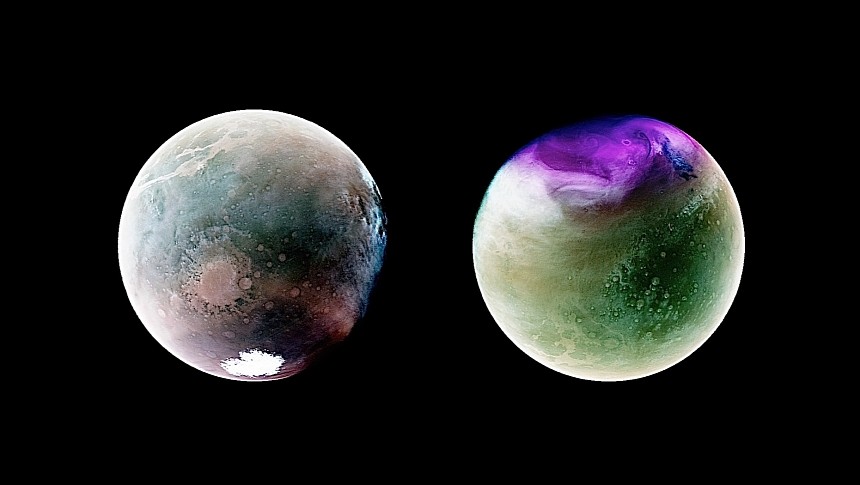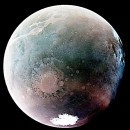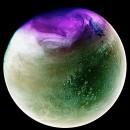Humans have a tendency to slap more or less appropriate nicknames on everything around them, and planets are no exception. Mars, for instance, the focus of so many dreamers, is also called the Red Planet, despite it being actually butterscotch, which is a sort of orangish-brown.
Whatever you call it, the place's strange color is something people have noticed as far back as the ancient Egyptians, who used to refer to the planet as The Red One.
We know now that the planet's color is owed to iron. There's plenty of the stuff embedded into Martian rocks, and after eons of exposure to the elements, most of it got oxidized, turning the color we see every day now.
The red in the soil has some peculiar effects, depending on conditions there. For instance, when kicked up into the atmosphere, the iron-filled dust turns the planet's sky pink.
So, quite colorful Mars is, but chances are you've never seen it before in purple. Because yes, the planet you can look at in the gallery attached to this piece is not some faraway alien planet, but good-old Mars.
The images you're looking at have been snapped by a spacecraft called Mars Atmosphere and Volatile EvolutioN. MAVEN for short, it is equipped with an ultraviolet spectrograph that measures wavelengths between 110 and 340 nanometers, meaning outside the visible spectrum.
To make these wavelengths visible, they are rendered in three ultraviolet wavelength ranges that have an incredible effect on what our eyes perceive: the planet’s ozone shows up as purple, clouds and hazes are white or blue, while the soil itself appears as tan or green.
MAVEN snapped the images in 2022 and 2023, as Mars was close to the opposite ends of its orbit around the Sun. The first image shows Mars during the southern hemisphere's summer season, revealing places such as the Argyre Basin, Valles Marineris, and the polar ice cap at the planet's south pole.
Image number two was taken as Mars moved past the farthest point of its orbit, when the seasons were changing. This causes an abundance of clouds and ozone.
Looking at the two images reveals just how spectacular Mars can be when looked at in new light, but there's a practical aspect to the whole thing as well. NASA is using the MAVEN and its instruments to "gain insight into the Martian atmosphere and view surface features in remarkable ways."
And that falls right in line with what MAVEN is tasked with doing, which would be exploring "the planet’s upper atmosphere, ionosphere, and interactions with the Sun and solar wind to explore the loss of the Martian atmosphere to space. "
We expect NASA to share more of the spacecraft exploits in the coming months. That's because next year MAVEN will be celebrating its tenth year in close proximity to the Red Planet.
We know now that the planet's color is owed to iron. There's plenty of the stuff embedded into Martian rocks, and after eons of exposure to the elements, most of it got oxidized, turning the color we see every day now.
The red in the soil has some peculiar effects, depending on conditions there. For instance, when kicked up into the atmosphere, the iron-filled dust turns the planet's sky pink.
So, quite colorful Mars is, but chances are you've never seen it before in purple. Because yes, the planet you can look at in the gallery attached to this piece is not some faraway alien planet, but good-old Mars.
The images you're looking at have been snapped by a spacecraft called Mars Atmosphere and Volatile EvolutioN. MAVEN for short, it is equipped with an ultraviolet spectrograph that measures wavelengths between 110 and 340 nanometers, meaning outside the visible spectrum.
To make these wavelengths visible, they are rendered in three ultraviolet wavelength ranges that have an incredible effect on what our eyes perceive: the planet’s ozone shows up as purple, clouds and hazes are white or blue, while the soil itself appears as tan or green.
MAVEN snapped the images in 2022 and 2023, as Mars was close to the opposite ends of its orbit around the Sun. The first image shows Mars during the southern hemisphere's summer season, revealing places such as the Argyre Basin, Valles Marineris, and the polar ice cap at the planet's south pole.
Image number two was taken as Mars moved past the farthest point of its orbit, when the seasons were changing. This causes an abundance of clouds and ozone.
Looking at the two images reveals just how spectacular Mars can be when looked at in new light, but there's a practical aspect to the whole thing as well. NASA is using the MAVEN and its instruments to "gain insight into the Martian atmosphere and view surface features in remarkable ways."
And that falls right in line with what MAVEN is tasked with doing, which would be exploring "the planet’s upper atmosphere, ionosphere, and interactions with the Sun and solar wind to explore the loss of the Martian atmosphere to space. "
We expect NASA to share more of the spacecraft exploits in the coming months. That's because next year MAVEN will be celebrating its tenth year in close proximity to the Red Planet.






